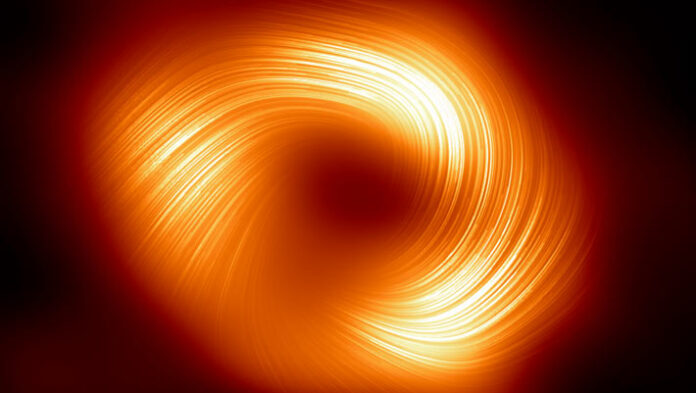According to astronomers’ best models of black hole evolution, the magnetic fields in the accretion disk need to be strong enough to push the accreting plasma around. The new results from Sagittarius A*, the 4.3-million-solar-mass black hole that resides at the center of the Milky Way Galaxy, and those from its much larger cousin M87* previously, provide the first direct observational evidence to support those models.
This image from the Event Horizon Telescope shows the polarized view of Sagittarius A*; the lines overlaid on this image mark the orientation of polarization, which is related to the magnetic field around the shadow of the black hole. Image credit: EHT Collaboration.
In 2022, astronomers from the EHT Collaboration unveiled the first image of Sagittarius A*, which is approximately 27,000 light-years away from Earth, revealing that while the Milky Way’s supermassive black hole is more than a thousand times smaller and less massive than M87’s, it looks remarkably similar.
This made the scientists wonder whether the two shared common traits outside of their looks. To find out, they decided to study Sagittarius A* in polarized light.
Previous studies of light around M87* revealed that the magnetic fields around the black hole giant allowed it to launch powerful jets of material back into the surrounding environment.
Building on this work, the new EHT images revealed that the same may be true for Sagittarius A*.
“What we’re seeing now is that there are strong, twisted, and organised magnetic fields near the black hole at the center of the Milky Way Galaxy,” said Dr. Sara Issaoun, an astronomer at the Harvard & Smithsonian’s Center for Astrophysics.
“Along with Sagittarius A* having a strikingly similar polarisation structure to that seen in the much larger and more powerful M87* black hole, we’ve learned that strong and ordered magnetic fields are critical to how black holes interact with the gas and matter around them.”
Light is an oscillating, or moving, electromagnetic wave that allows us to see objects. Sometimes, light oscillates in a preferred orientation, and scientists call it polarized.
Although polarized light surrounds us, to human eyes it is indistinguishable from ‘normal’ light.
In the plasma around these black holes, particles whirling around magnetic field lines impart a polarisation pattern perpendicular to the field.
This allows astronomers to see in increasingly vivid detail what’s happening in black hole regions and map their magnetic field lines.
“By imaging polarized light from hot glowing gas near black holes, we are directly inferring the structure and strength of the magnetic fields that thread the flow of gas and matter that the black hole feeds on and ejects,” said Dr. Angelo Ricarte, an astronomer at Harvard University and the Harvard & Smithsonian’s Center for Astrophysics.
“Polarized light teaches us a lot more about the astrophysics, the properties of the gas, and mechanisms that take place as a black hole feeds.”
But imaging black holes in polarized light isn’t as easy as putting on a pair of polarized sunglasses, and this is particularly true of Sagittarius A*, which is changing so fast that it doesn’t sit still for pictures.
Imaging the supermassive black hole requires sophisticated tools above and beyond those previously used for capturing M87*, a much steadier target.
“Sagittarius A* is like a frenetic toddler,” said University of Waterloo’s Professor Avery Broderick.
“We’re seeing for the first time the invisible structure that shepherds the material within the black hole’s disk and drives plasma to the event horizon, helping it to grow.”
“Because Sagittarius A* moves around while we try to take its picture, it was difficult to construct even the unpolarized image,” said Dr. Geoffrey Bower, an astronomer with the Institute of Astronomy and Astrophysics at Academia Sinica, Taipei.
“The first image was an average of multiple images owing to Sagittarius A*’s movement.”
“We were relieved that polarized imaging was even possible. Some models were far too scrambled and turbulent to construct a polarized image, but Nature was not so cruel.”
“With a sample of two black holes — with very different masses and very different host galaxies — it’s important to determine what they agree and disagree on,” said University of Naples Federico II’s Professor Mariafelicia De Laurentis.
“Since both are pointing us toward strong magnetic fields, it suggests that this may be a universal and perhaps fundamental feature of these kinds of systems.”
“One of the similarities between these two black holes might be a jet, but while we’ve imaged a very obvious one in M87*, we’ve yet to find one in Sagittarius A*.”
The findings appear in two papers (paper #1 & paper #2) in the Astrophysical Journal Letters.
_____
The Event Horizon Telescope Collaboration. 2024. First Sagittarius A* Event Horizon Telescope Results. VII. Polarization of the Ring. ApJL 964, L25; doi: 10.3847/2041-8213/ad2df0
The Event Horizon Telescope Collaboration. 2024. First Sagittarius A* Event Horizon Telescope Results. VIII. Physical Interpretation of the Polarized Ring. ApJL 964, L26; doi: 10.3847/2041-8213/ad2df1


